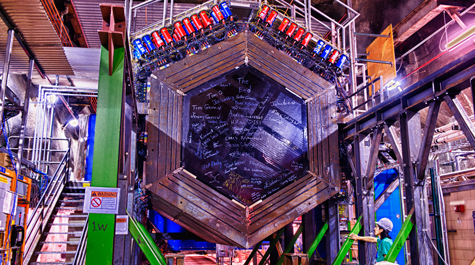‘Neutrinophone’ listed among top 10 physics breakthroughs for 2012
A cadre of William & Mary’s physicists was involved in a project that made the Physics World list of the top 10 breakthroughs for 2012.
“Some Higgs thingie was number one,” deadpans Jeff Nelson, the Cornelia B. Talbot Term Distinguished Associate Professor of Physics at William & Mary. Nelson refers to the July discovery of the Higgs boson (or something very much like it) at CERN’s Large Hadron Collider.
Physics World is a publication of the Institute of Physics, one of the world’s foremost scientific bodies. The magazine’s top ten list was compiled based on criteria that include the fundamental importance of research, significant advancement in knowledge, strong connection between theory and experiment, and general interest to all physicists. After the top breakthrough, the remainder of the Physics World list is unranked.
It was the “neutrinophone” that made the top ten. The neutrinophone was a side project of an ambitious experiment at the Fermi National Accelerator Laboratory known as MINERvA. Nelson points out that MINERvA has, over the years, involved dozens of people from the William & Mary Department of Physics, including faculty, post-docs, graduate and undergraduate students and even several of the department staff.
The purpose of MINERvA is to study the ways neutrinos oscillate—or change types. The neutrinophone used the tertiary beam at Fermilab to send the world’s first message using the ubiquitous subatomic particles. The physicists used a binary code to send a message. A burst of neutrinos was a zero; no neutrinos meant a one.
The first message: “neutrino.” Despite the simple beginning, and the stunt-like nature of the event, the neutrinophone holds great promise for the future. (Star Trek characters use neutrino communication.)
“If you want to send a message across the universe—or to a submarine deep below the waves—then neutrinos could be your best bet,” Physics World wrote in its top-ten article. “Your message would be guaranteed to get there because the subatomic particles can easily pass through 1,000 light-years of lead without being affected. The problem, however, is how to encode and detect a signal using particles that react very rarely with matter.”
 Skip to main content
Skip to main content

